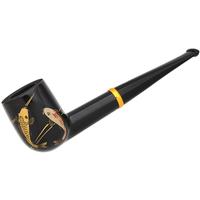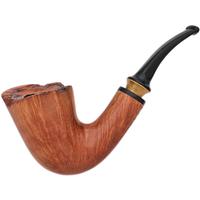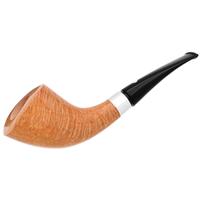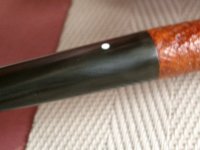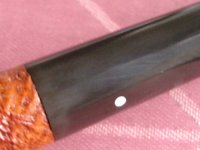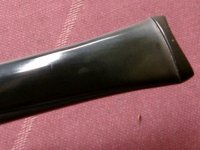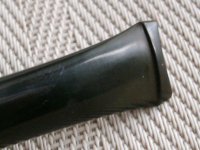Recently I got This NOS Dunhill pipe , and all I knew ,based on my experience in the past, I may have to deal with hidden' stem oxidation, eventually my expectations come true,,there is an easily detectable underlaying stem oxidation which ,in all probability, will be getting worse in the future,now, In order to restore luster,may I ask for your expert advise on how to avoid rounding stem shoulders (,the area where this moderate oxidation seems to be most obvious) and how to avoid defacing the white spot stem logo? Is it suitable to use liquide plastic cleaning agents such as meguiar's or may be toothpaste/baking soda compound will do the trick as well ?The described oxidation is not bad yet,but inevitably will become so ,Thank You for Your time,Your opinion is greatly appreciated
Looking for Tips : Moderate Oxidation Removal on Vulcanite Stems
- Thread starter PaulTheScandinavian
- Start date
You are using an out of date browser. It may not display this or other websites correctly.
You should upgrade or use an alternative browser.
You should upgrade or use an alternative browser.
Mr. Clean Magic Erasersmay I ask for your expert advise on how to avoid rounding stem shoulders
Those go pretty deep. You have to be trying to remove them to damage them.how to avoid defacing the white spot stem logo?
Flitz metal polish.restore luster
Thank You very much Chasing, How would you think if those special oxidation removal liquids sold by pipe restoration shops might be effective?Mr. Clean Magic Erasers
Those go pretty deep. You have to be trying to remove them to damage them.
Flitz metal polish.
Mr. Clean Magic Erasers
What “level?” I see regular, 2x, 4x, etc.
Do you have sand paper and micromesh pads? I start at 800grit if it’s a special stem and just take my time, pretty much wet sanding the whole way. Finish with a generous coat of obsidian/mineral oil and leave on for 30mins or so before buffing off with a cloth.
Before sanding, I wash stem in warm/hot water to draw out any oxidisation to surface and then rub/scrub with a tooth brush some bathing soda/tooth paste all over.
Is there any oxidisation inside the stem too?
Before sanding, I wash stem in warm/hot water to draw out any oxidisation to surface and then rub/scrub with a tooth brush some bathing soda/tooth paste all over.
Is there any oxidisation inside the stem too?
Without seeing detailed pictures of the stem it's hard to make a specific recommendation. The basic fact that every professional restorer I've spoken with over the years says is this, the affected material must be fully removed or it will continue to affect the surrounding material. There are a number of ways to remove that material.
I generally use a set of micromesh pads to do this, starting with coarser grits and finishing with finer grits under running water. I find that I can control the effect of sanding away the damaged material very well with the pads. It's a little like carefully shaping a piece of gold when I used to do jewelry restoration. Removing oxidation from the airway is a little more involved, but the principle is the same, removing the affected material with an abrasive and finishing with a very mild abrasive that also pol9shes. When I use micromesh pads, the final few grades leave a very high mirror-like gloss. I will coat the finished stem with a microcrystalline wax as a barrier against oxidation. Keep the Vulcanite stems away from sunlight.
Once in a while I'll do a rub down with some Simichrome on a cloth to get rid of any thin deposit left around the bite zone while leaving the Vulcanite alone.
I generally use a set of micromesh pads to do this, starting with coarser grits and finishing with finer grits under running water. I find that I can control the effect of sanding away the damaged material very well with the pads. It's a little like carefully shaping a piece of gold when I used to do jewelry restoration. Removing oxidation from the airway is a little more involved, but the principle is the same, removing the affected material with an abrasive and finishing with a very mild abrasive that also pol9shes. When I use micromesh pads, the final few grades leave a very high mirror-like gloss. I will coat the finished stem with a microcrystalline wax as a barrier against oxidation. Keep the Vulcanite stems away from sunlight.
Once in a while I'll do a rub down with some Simichrome on a cloth to get rid of any thin deposit left around the bite zone while leaving the Vulcanite alone.
In my experience there's no replacement for physical removal. I personally use a lighter and a wet paper towel to remove oxidation but if you have no experience shaping or reshaping stems with heat, you may do more damage than good.Thank You very much Chasing, How would you think if those special oxidation removal liquids sold by pipe restoration shops might be effective?
Prior to my lighter technique, I used these.What “level?” I see regular, 2x, 4x, etc.
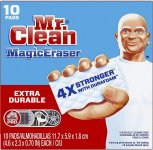
If just beginning with oxidation removal, even fine sandpaper and micro mesh can ruin the shape of a stem.Do you have sand paper and micromesh pads?
I've found that Magic erasers are a little aggressive, and the grits are uneven, leaving sanding marks that will take even more work to remove.
Way before the interwebs, I used to use an old terrycloth towel, and sprinkle 4F pumice on it. Secured one side of the towel in a vice and then rub the stem back and forth to remove the oxidation; then use another towel with rottenstone to bring it up to a high polish. This was just to maintain my own smaller collection of pipes. And it's pretty tough to ruin the geometry of the stem edges that way. Time consuming though.
Once I started buying estates, I began using sandpaper to remove the oxidation. Takes some practice to do it without removing too much or smearing details.
Now I use sandpaper and a buffing wheel.
I consider the following videos the definitive way to go about it...
Way before the interwebs, I used to use an old terrycloth towel, and sprinkle 4F pumice on it. Secured one side of the towel in a vice and then rub the stem back and forth to remove the oxidation; then use another towel with rottenstone to bring it up to a high polish. This was just to maintain my own smaller collection of pipes. And it's pretty tough to ruin the geometry of the stem edges that way. Time consuming though.
Once I started buying estates, I began using sandpaper to remove the oxidation. Takes some practice to do it without removing too much or smearing details.
Now I use sandpaper and a buffing wheel.
I consider the following videos the definitive way to go about it...
Thank You for your time and input gents,the very stem has nothing but a light oxidation which is perceptible under the direct daylight and only at closer inspection, bite zone and the whole stem tends to get a bit dull if I wash it with warm water ,but then gets back to black after mineral oil is applied and rubbed out, the airway seems to be ok,i may include close up photo of it later,btw, to my great surprise ,I have to tell you folks,this very Dunhill might be the one of my best performing pipes I have ever owned,no other Dunhill I have had or still have comes even close
I really like the micromesh pads. I punch holes in them with a paper punch and keep them on a large keyring, which makes it easier to use them in succession, more abrasive to less. Some of the other ways that get mentioned on these types of threads is also a use of abrasion, just from different sources. They should all do the same thing.
I like the pads because it goes quickly. I just use them at a sink under running water, a few seconds with each pad.
But, after I get them polished, I just keep them polished by hitting them with a jeweler's cloth after each smoke, so that I don't have to keep using the pads.
Don't worry about the white spot, as chasingembers said, they are deep, a piece of white rod that has been inserted into place. You wouldn't be able to abrade it away unless you just destroyed the stem.
I like the pads because it goes quickly. I just use them at a sink under running water, a few seconds with each pad.
But, after I get them polished, I just keep them polished by hitting them with a jeweler's cloth after each smoke, so that I don't have to keep using the pads.
Don't worry about the white spot, as chasingembers said, they are deep, a piece of white rod that has been inserted into place. You wouldn't be able to abrade it away unless you just destroyed the stem.
That looks pretty darn good. It just needs a polish. With the micro mesh pads, you can just start at one of the very fine ones and knock that out in seconds. I don't think you should start that one with 600 grit at all. You'd be removing a lot of material. If it were green with oxidation, then yeh, 600 the hell out of it.
Maybe not with micromesh but with a microfiber cloth and some simichrome, or a very fine
ebonite polish . I had some amazing results with a plastic scratch remover or car lacquer polish.
Time consuming and tiresome, but rewarding.
Like Jesse said; Renaissance wax works great to prevent further oxidation !
As George's video shows very fine nail buffers do a good job; they go with the flow of the stem.
I use them without sanding paper.
Almost forgot ; I make my own oxidation remover from pumice powder and mineral oil !
Trial and error
ebonite polish . I had some amazing results with a plastic scratch remover or car lacquer polish.
Time consuming and tiresome, but rewarding.
Like Jesse said; Renaissance wax works great to prevent further oxidation !
As George's video shows very fine nail buffers do a good job; they go with the flow of the stem.
I use them without sanding paper.
Almost forgot ; I make my own oxidation remover from pumice powder and mineral oil !
Trial and error
Last edited:
Have you seen micromesh pads in person? The finest is down to a glossy finish. Microfiber is the same exact thing except on e amore flexible surface, and Simichome is just another form of fine abrasive. They are all the same, and yep, they work.Maybe not with micromesh but with a microfiber cloth and some simichrome, or a very fine
ebonite polish .
I just find it easier to use the pads on a large keyring. But, whatever works.
Yes, in the flesh and I could not do without them anymore !Have you seen micromesh pads in person? The finest is down to a glossy finish. Microfiber is the same exact thing except on e amore flexible surface, and Simichome is just another form of fine abrasive. They are all the same, and yep, they work.
I just find it easier to use the pads on a large keyring. But, whatever works.
Only disadvantage; they're quite expensive and do not last that long.
I purchase 4000 grit nail buffers by the hundreds; dirt cheap and do an amazing job ,
also to polish the briar.
Last edited:
This is why i just use them under running water. It keep the abrasive from getting caked in debris and then tearing. But, I just use them once on estate pipes, and then use the jeweler's cloth after each smoke to keep my pipes pristine, and Renaissance wax is great too. Just a smidge on my finger, rub on the stem, and then wipe it all away, but I don't use this often. It also is great for keeping silver from tarnishing.Yes, in the flesh and I could not do without them anymore !
Only disadvantage; they're quite expensive and do not last that long.
Jeweler's cloth ?This is why i just use them under running water. It keep the abrasive from getting caked in debris and then tearing. But, I just use them once on estate pipes, and then use the jeweler's cloth after each smoke to keep my pipes pristine, and Renaissance wax is great too. Just a smidge on my finger, rub on the stem, and then wipe it all away, but I don't use this often. It also is great for keeping silver from tarnishing.
the inside cloth has a slight polishing abrasive that doesn't remove much material, but oxides seems to stick to it, and it bring sup a nice polish. The outside cloth has a microcrystalline wax (like Renaissance wax) impregnated into it, so that it coats the stem to prevent oxidation.Jeweler's cloth ?
After I start smoking a pipe, I never have issues with oxidation.
Thank you my friend; will haunt our local jeweler ( to avoid shipping costs ) ; I'm dutch, we need to live up to our reputationthe inside cloth has a slight polishing abrasive that doesn't remove much material, but oxides seems to stick to it, and it bring sup a nice polish. The outside cloth has a microcrystalline wax (like Renaissance wax) impregnated into it, so that it coats the stem to prevent oxidation.
After I start smoking a pipe, I never have issues with oxidation.



